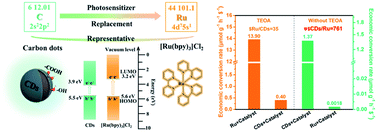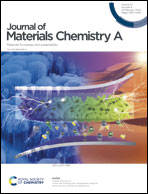Replacing Ru complex with carbon dots over MOF-derived Co3O4/In2O3 catalyst for efficient solar-driven CO2 reduction†
Abstract
Photocatalytic conversion of CO2 to fuels is one of the most promising methods to reduce carbon emissions and store solar energy. Many developed catalysts require noble metal complex photosensitizers, as well as additional sacrificial agents. Using earth-abundant photosensitizers to replace these noble metal complexes is an urgent task. Here, we report highly stable carbon dot (CD)-modified Co3O4/In2O3 composite (CDs-M-CIO) photocatalysts for efficient solar-driven CO2 reduction. Such CD-based photocatalysts exhibit a high solar-driven CO generation rate of 2.05 μmol h−1 g−1 without a sacrificial agent, which is nearly 3.2 times higher than the rate for the [Ru(bpy)3]Cl2 catalyst under the same conditions. With regard to economic cost, the CO generation rate of the CD catalyst is dramatically improved, up to 761 times, compared with that of the Ru catalyst. Transient photovoltage experiments reveal that CDs take part in both the electron and hole transfer processes, stabilize charge and enrich H+ for efficient CO2 reduction. This work proposes a novel way to design exceptionally low-cost carbon material as a photosensitizer without a sacrificial agent for enhancement of CO2 photoreduction.



 Please wait while we load your content...
Please wait while we load your content...